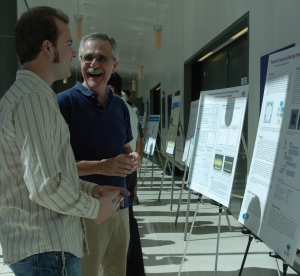Calit2 Associate Director Bill Hodgkiss Delves Deep to Research RF and Acoustic Communications
San Diego, CA, July 15, 2008 -- Underwater acoustician Bill Hodgkiss might be a faculty member at UC San Diego's Scripps Institution of Oceanography, but he didn't grow up with an intimate connection to the ocean. What drew him to the profession was the science behind the sea.
|
Even when he did get up close and personal with the Pacific, it was on a strictly professional basis. Hodgkiss got his start in underwater acoustics in 1975 at the San Diego-based Naval Ocean Systems Center (NOSC), a predecessor of SPAWAR Systems Center, now a naval laboratory located in Point Loma. The Navy had funded Hodgkiss’ research in theoretical signal processing while he was in graduate school at Duke University (research that was relevant to both radio-frequency communications and underwater acoustics) and later hired him at NOSC to work with data from arrays of hydrophone sensors. It was there that Hodgkiss says he developed an interest in real data analysis as opposed to theoretical simulations – a real-world focus that persists in his role as associate director and a principal research investigator at Calit2.
"The interest I’ve always had in working with real data is an underpinning of what we do here at Calit2,” Hodgkiss explains. “Doing field work and working with real sensor data is very much what we’re involved in doing, and I think that’s great."
At Calit2, Hodgkiss is also leading a joint effort with the U.S. Department of Defense (DoD) Joint Tactical Radio System (JTRS) and SPAWAR to develop software-defined radios. The project, which is run under the auspices of the Pentagon's Joint-Program Executive Office (JPEO), has sweeping implications for the military, both in terms of cost-savings and efficiency, because the JTRS would allow the Army, Navy, Air Force and Marines to communicate with one another over a single radio system, rather than having separate systems for each military branch.
“It’s no big surprise that in the past, many of the Armed Services developed their own separate radio systems instead of developing systems that would be mutually useful,” notes Hodgkiss, who is the project’s principal investigator. “That approach is fine, as long as they don’t have to talk to each other. The JPEO is essentially attempting to design a system that will interoperate across services so they won’t have to design and build one system per service, since that doesn’t make any sense. “
|
Explains Hodgkiss: “There’s the difficulty of communicating with legacy hardware and there’s the difficulty of not having a radio be all things to all people. But, even in the face of all of those obvious challenges, the military is trying to look towards the future. The JTRS program is pushing ahead with the notion of radios that will be software-definable, which means putting as much as they can into software, and the least amount into hardware, so the radio is more flexible over its lifetime. Rather than having to replace a physical part or throw the radio away, you can just upload some new software to it that does something new."
According to Hodgkiss, looking to the future is where Calit2 comes in. "Software-defined radio is an area that Calit2 has existing strength in, and we want to develop that strength," he says. "Additionally, it’s an opportunity for us to interact with SPAWAR’s engineers, who have deep experience in software-defined radio. This engagement will be of larger benefit to UCSD, because we’ll be educating undergrads and graduate students in this emerging area of communications, and those students are then potential future employees of the DoD or industries working on software-defined radio problems. I think it’s going to be a very successful project."
It’s a testament to Hodgkiss’ wide-ranging interests that software-defined radio – although currently his primary focus at Calit2 – bears only marginal relation to his work as an underwater acoustician at Scripps.
"Because the ocean is salt water, you can’t use radio waves to communicate underwater," he explains. “Radio energy doesn’t propagate to any significant depth underwater. What does propagate well underwater is acoustic energy."
Hodgkiss’ work in that field has primarily focused on three research topics: 1) signal processing applied to hydrophone arrays; 2) geoacoustic inversion; and 3) acoustic communications. All three areas are concerned with understanding how sound waves propagate through water, and how variables such as ocean temperature, sea-surface conditions, air humidity, salinity, seafloor topography and ocean currents can affect propagation of acoustic energy.
Hodgkiss completed his most recent work in the field last week, when he returned from 18 days at sea off the west coast of Kauai, Hawaii. Onboard the R/V Melville, a Scripps research vessel, he and a team of 15 researchers studied the effects of fluctuations in the ocean environment on underwater acoustic communications.
One application of such research is to enable devices and systems to communicate at higher data rates using multiple transducers at each device – an area of overlapping interest to his colleagues at Calit2.
|
"What drives us all in a university environment is doing research where the questions are open-ended,” he continues. “As a faculty member, I have a great deal of freedom in deciding the problems that I want to work on. I think that’s heightened by a collaborative environment such as the one at Calit2, because there are so many exciting areas of research to get involved in. I think all of us realize there’s only so much we can do on our own in terms of uniquely doing a piece of research. In a collaborative environment you can draw together the expertise of many people, and therefore do a very different kind of research, which will have a different impact. I think that makes it an incredibly exciting environment to be in.”
Related Links
Bill Hodgkiss' Bio and Research
Scripps Institution of Oceanography
Marine Physical Laboratory
Media Contacts
Tiffany Fox, tfox@ucsd.edu, (858) 246-0353



